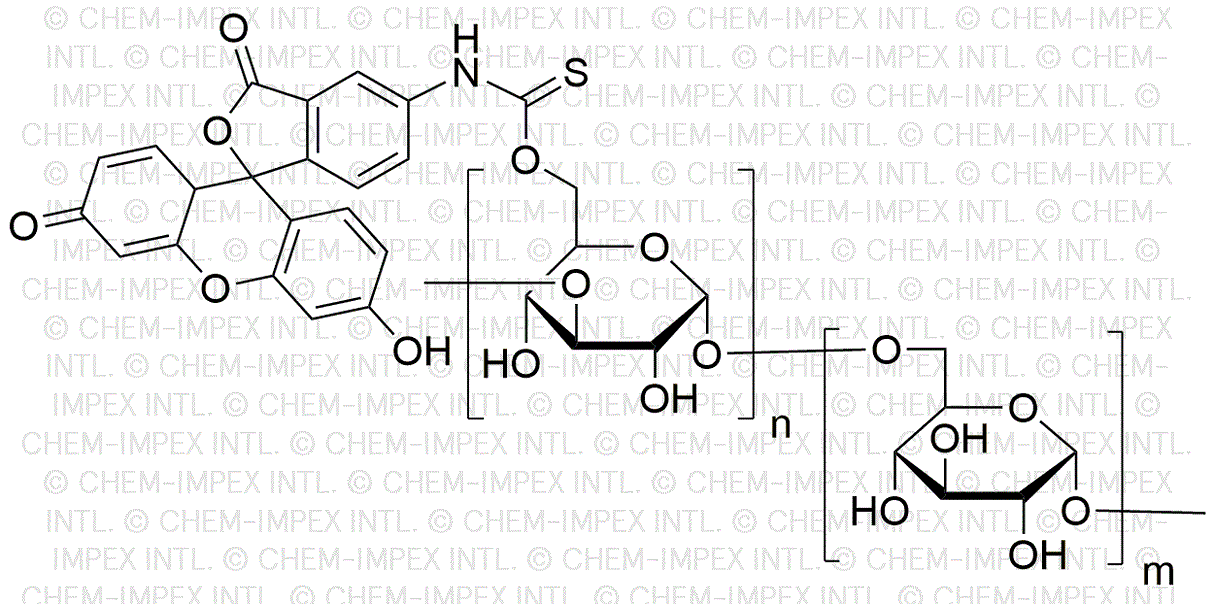Fluorescein isothiocyanate–dextran average mol wt 10,000 is widely utilized in research focused on:
- Cell Tracking: This compound is commonly used in cellular biology to label and track cells in vivo, allowing researchers to visualize cell migration and behavior in real-time.
- Fluorescence Microscopy: It serves as a fluorescent marker in microscopy, enhancing the visibility of cellular structures and processes, which is crucial for detailed imaging studies.
- Drug Delivery Studies: In pharmaceutical research, it helps in evaluating the efficacy of drug delivery systems by tracking the distribution of therapeutic agents within biological tissues.
- Immunohistochemistry: This compound is employed in staining tissues to identify specific proteins, aiding in the diagnosis of diseases and the understanding of pathological processes.
- Vascular Studies: It is used to study blood flow and vascular permeability, providing insights into cardiovascular health and disease mechanisms.
General Information
Properties
Safety and Regulations
Applications
Fluorescein isothiocyanate–dextran average mol wt 10,000 is widely utilized in research focused on:
- Cell Tracking: This compound is commonly used in cellular biology to label and track cells in vivo, allowing researchers to visualize cell migration and behavior in real-time.
- Fluorescence Microscopy: It serves as a fluorescent marker in microscopy, enhancing the visibility of cellular structures and processes, which is crucial for detailed imaging studies.
- Drug Delivery Studies: In pharmaceutical research, it helps in evaluating the efficacy of drug delivery systems by tracking the distribution of therapeutic agents within biological tissues.
- Immunohistochemistry: This compound is employed in staining tissues to identify specific proteins, aiding in the diagnosis of diseases and the understanding of pathological processes.
- Vascular Studies: It is used to study blood flow and vascular permeability, providing insights into cardiovascular health and disease mechanisms.
Documents
Safety Data Sheets (SDS)
The SDS provides comprehensive safety information on handling, storage, and disposal of the product.
Product Specification (PS)
The PS provides a comprehensive breakdown of the product’s properties, including chemical composition, physical state, purity, and storage requirements. It also details acceptable quality ranges and the product's intended applications.
Certificates of Analysis (COA)
Search for Certificates of Analysis (COA) by entering the products Lot Number. Lot and Batch Numbers can be found on a product’s label following the words ‘Lot’ or ‘Batch’.
*Catalog Number
*Lot Number
Certificates Of Origin (COO)
This COO confirms the country where the product was manufactured, and also details the materials and components used in it and whether it is derived from natural, synthetic, or other specific sources. This certificate may be required for customs, trade, and regulatory compliance.
*Catalog Number
*Lot Number
Safety Data Sheets (SDS)
The SDS provides comprehensive safety information on handling, storage, and disposal of the product.
DownloadProduct Specification (PS)
The PS provides a comprehensive breakdown of the product’s properties, including chemical composition, physical state, purity, and storage requirements. It also details acceptable quality ranges and the product's intended applications.
DownloadCertificates of Analysis (COA)
Search for Certificates of Analysis (COA) by entering the products Lot Number. Lot and Batch Numbers can be found on a product’s label following the words ‘Lot’ or ‘Batch’.
*Catalog Number
*Lot Number
Certificates Of Origin (COO)
This COO confirms the country where the product was manufactured, and also details the materials and components used in it and whether it is derived from natural, synthetic, or other specific sources. This certificate may be required for customs, trade, and regulatory compliance.


